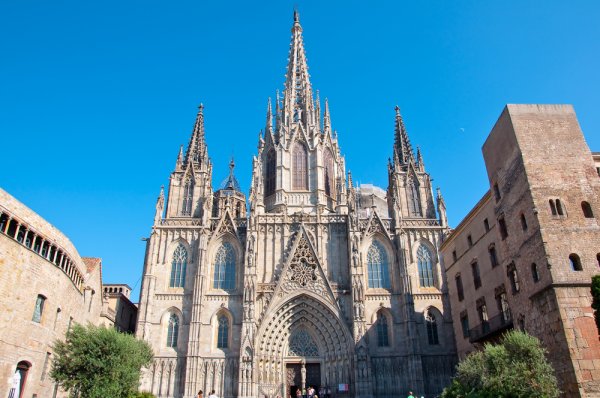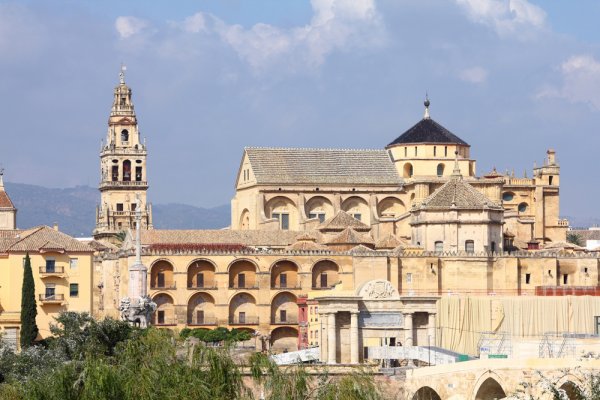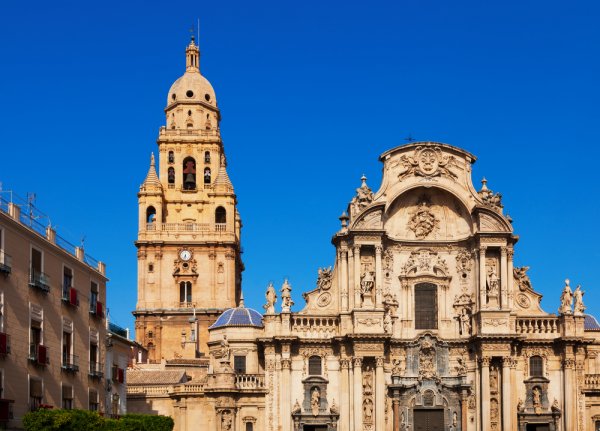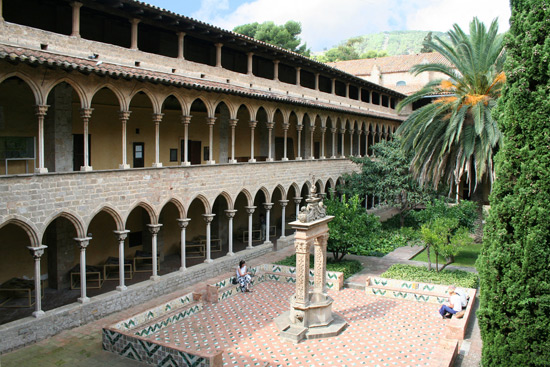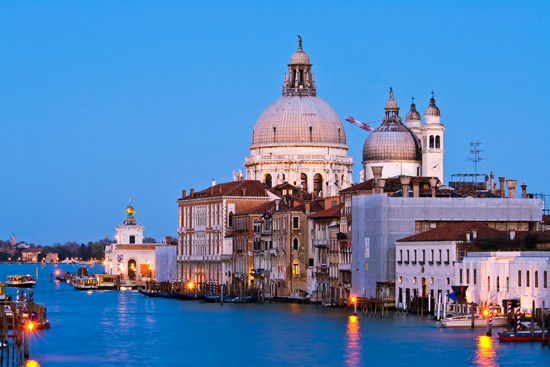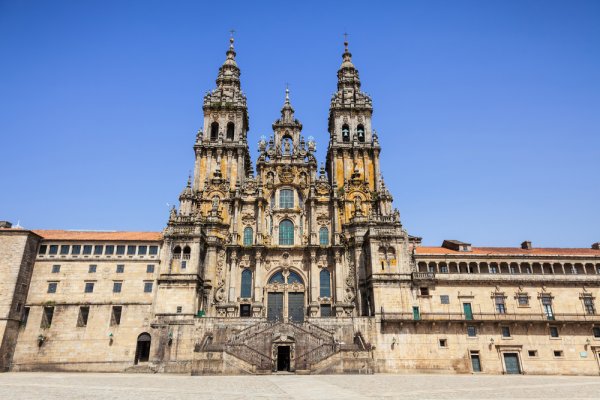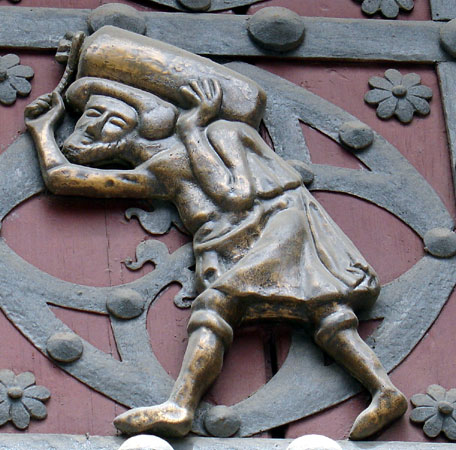Points of Interest
Barcelona Cathedral
Catedral de Barcelona s/n Pla de la Seu Gothic District
Barcelona, Catalonia 08002, Spain
Popularly known as the La Seu, this cathedral is dedicated to Saint Eulalia, co-patron saint of Barcelona, and is the seat of the Roman Catholic Archbishop of Barcelona. This Gothic cathedral was built in 1298 on top of a former Visigoth church. The Gothic façade and the spire were added in the 19th century based on the design of French architect Charles Galters. The octagonal clock towers have a height of 50 meters (164 feet). The interior includes a wide nave, 28 side chapels, a carved choir, and a crypt containing the sarcophagus of Santa Eulalia. A 14th-century cloister with a central courtyard and a small museum adjoins the cathedral.
Great Mosque
Cathedral of Cordoba 1 Calle del Cardenal Herrero
Córdoba 14003, Spain
This masterpiece of Moorish architecture brings throngs of visitors each year. Cordoba served as Spain's center of Islamic power, and its mosque, once the second largest in the world, displays exquisite artistry. Towering stone walls with massive, bronze doors that close each night encircle the structure and its garden. The mosque's interior features more than 850 granite, jasper and marble columns; ornate ceiling freize patterns; and elaborate altars of the later Christian influence. A cathedral was built inside the mosque in the 16th century and takes up less than half of the interior, as King Ferdinand III didn't wish to destroy the artistry of the Moors. The exterior of the mosque-cathedral boasts a classic, Moorish garden complete with a grove of orange trees. Outside the mosque walls, one will find the old, Moorish section of Cordoba, another treasure well worth exploring.
Hermitage of Saint Anthony of La Florida
Ermita de San Antonio de la Florida Glorieta de San Antonio de la Florida 4
Madrid 28008, Spain
If you're a lover of Goya, head to this church on the banks of the Manzanares, where he not only executed one of his most splendid works, but where he is also buried. The neoclassical church was constructed between 1792 and 1798; Goya painted his exceptional fresco over several months in the final year of building. Depicting the miracles of St. Anthony of Padua, Goya used some artistic license in relocating one of the incidents from Lisbon to Madrid. Look for the artist appearing in his own work: He's the man almost covered by his black cloak. Young single women attend this church on June 13 every year to pray for a partner. Although Goya died in Bordeaux, France, his body was reinterred here in 1919. Interestingly, the artist's head was stolen in France, so only his body is buried here.
La Sagrada Familia
401 Carrer de Mallorca
Barcelona 08013, Spain
Usually referred to simply as La Sagrada Familia (The Holy Family), this large Roman Catholic basilica is expected to be completed in 2026. The original designer, Antoni Gaudí, infused the design with Christian symbolism and intended the cathedral to be the greatest icon of Christendom. After Gaudí's death, other eminent architects resumed work on the cathedral. One of the striking features of the cathedral is the 18 spindle-shaped towers representing the 12 apostles, four evangelists, the Virgin, and Christ. The eastern façade, called the Nativity Façade, reflects a Baroque style, and is situated opposite to the Passion Façade, which includes abstract depictions of the crucifixion. The southern face, or Glory Façade, depicts the life and death of humankind.
Murcia Cathedral
Catedral de Murcia 1 Plaza del Cardenal Belluga
Region of Murcia 30001, Spain
Murica Cathedral was constructed on the site of the former Great Mosque or Aljamía. The cathedral was completed in 1467 but continued to grow until the 18th-century, incorporating various artistic styles. The cathedral's façade is from the Baroque period, with a bell tower that measures 90 meters (295 feet) in height and has distinctively styled stages. Some important chapels include the Vélez Chapel in a Flaming Gothic style, the baroque-style Chapel of the Immaculate, and the Chapel of the Junterones of the Spanish Renaissance. The remains of King Alfonso X the Wise are interred under the main altar.
Pedralbes Monastery
Monestir de Pedralbes 9 Baixada del Monestir
Barcelona 08034, Spain
Named after its white stones (pertas albes in Catalan), this serene monastery was founded in 1326 by Elisenda de Montcada, the queen of Jaume II. Once the convent of the Order of St. Clare, it is now Barcelona's best example of Gothic cloisters, a three-story quadrilateral at the base of which are an herb garden, fountain, and well. There is also a church that contains Giotto-esque murals by Catalan artist Ferrer Bassa. In the residence where the nuns used to live, visitors can see original artifacts, tour the refectory, and recreate the ordinary lives of the St. Clare sisters. Look on the floor of the arcaded walkways of the church for the wheel marks carved by Napoleon's cannons, evidence of the French occupation of 1809.
Santa Maria della Salute
Salute Venice, Spain
With its marshy air and close-packed houses, Venice in the Middle Ages was especially vulnerable to the plague. In 1630, after losing more than 45,000 residents, the city commissioned Baldessare Longhena to build a church to thank the Virgin Mary for saving Venice. Longhena, a pupil of Palladio, was a relatively young man when construction began in 1631. The project would outlast him and take more than half a century to complete. His church, known locally as La Salute, is octagonal and made of stone quarried from Istria. The sacristy includes a little art gallery featuring works by Titian and Tintoretto. In the 17th century, the Senate would visit La Salute annually to offer thanks to the Virgin, and ordinary Venetians still come here on November 21 each year to give thanks for another year of health.
Santiago de Compostela Cathedral
Cathedral de Santiago s/n Praza do Obradoiro
Santiago de Compostela 15704, Spain
The cathedral is famous as the burial-place of Saint James the Great and has been a major pilgrimage destination since the Middle Ages. The 97-meter-long (318-foot-long) and 22-meter-tall (72-foot-tall) cathedral is one of the largest Romanesque churches in Europe. It has a barrel-vaulted cruciform Romanesque interior with a golden mollusk shell that adorns the altar. The relics of St. James are placed in a silver coffer beneath the high altar. The 12th-century Portico de la Gloria, with its sculptures on the Last Judgment, is one of the cathedral's most magnificent features. Legend has it that a gold crucifix kept in the chapel contains a piece of the True Cross.
St. Mary of the Sea Basilica
Basílica de Santa María del Mar 1 Plaça de Santa Maria
Barcelona 08003, Spain
Built in honor of the region's sailors and fishermen, St. Mary of the Sea has a stark simplicity in its Catalan Gothic design. It was constructed between 1329 and 1384, a remarkably speedy accomplishment for the time. Local artisans were enlisted in the huge project, with all local porters ordered to devote one day a week carrying stone from the quarry in Montjuïc. Look for tributes to the porters throughout the church, for example in relief carvings in the main doors. St. Mary of the Sea's lack of ostentation gives it a democratic air-it was the traditional church of Ribera workers (the wealthy attended services in the cathedral). Its austerity was even more pronounced following an 11-day fire in 1936, when anarchists torched the interior in protest against the Catholic Church siding with General Franco.
Copyright © 1993—2024 World Trade Press. All rights reserved.

 Spain
Spain 